Rennes hosted Montpellier this past Sunday afternoon in a Ligue 1 fixture. Rennes took a big step towards securing a place in the UEFA Champions League’s third qualifying round for next season, as they earned a dominant 5-0 victory over a Montpellier side who sat seven points behind them in the league going into this game.
Rennes’ dominant win over Montpellier keeps them in third place in the Ligue 1 table, just one point ahead of fourth-placed Lille. Meanwhile, Sunday afternoon’s heavy defeat saw Montpellier slump to eighth place in the Ligue 1 table, now sitting 10 points away from third-placed Rennes in Ligue 1’s final Champions League qualification spot.
Rennes earned their largest Ligue 1 win of the 2019/20 season in last Sunday’s clash with Montpellier. This tactical analysis piece will examine the tactics that were deployed by Julien Stéphan’s Rennes side in this past weekend’s game. Furthermore, we will provide a thorough tactical analysis of the different shapes that were utilised by both of these teams in this game, in addition to providing details on some of the key elements of both of these sides’ respective tactics for this recent Ligue 1 fixture.
Lineups and formations
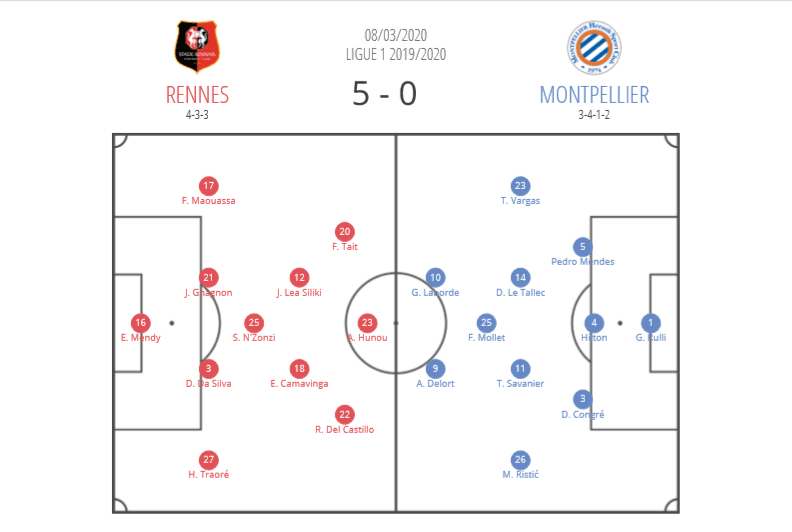
Rennes lined up in a 4-3-3 shape for Sunday’s game versus Montpellier. Les Rennais haven’t utilised a 4-3-3 on many occasions this season, however, the three-man midfield allowed Les Rennais to play Eduardo Camavinga, James Léa Siliki, and January signing Steven N’Zonzi together, which was an important part of their gameplan for this fixture, as it turned out. We will discuss this at greater length later in this tactical analysis piece.
Despite a change in system, there were no surprises in defence for Rennes in this one as they deployed their regular back four and goalkeeper here. Meanwhile, Flavien Tait and Romain Del Castillo played on either side of Adrien Hunou, who started in the centre forward position in Sunday’s fixture.
Meanwhile, Montpellier boss Michel Der Zakarian didn’t spring too many surprises with his choice of shape for Sunday’s visit to Roazhon Park. Montpellier lined out in their familiar 3-4-1-2 shape for this past weekend’s game.
However, Montpellier’s regular pair of wing-backs, Ambroise Oyongo and Arnaud Souquet didn’t feature in this past Sunday’s game. Instead, Montpellier lined out with 19-year-old Thibaut Vargas playing at right wing-back, while Mihailo Ristić started at left wing-back for Montpellier versus Rennes. Other than the two wing-backs, Montpellier may have been at full strength for their recent visit to Rennes.
Montpellier’s shape and defensive struggles
The visiting side’s 3-4-1-2 shape was evident right from the kick-off in Sunday’s Ligue 1 game. Upon getting this clash underway, the majority of Montpellier’s starting 11 immediately sprinted forward to occupy positions inside the opposition’s half, while creating their 3-4-1-2 shape.
Within seconds of this game getting underway, Montpellier’s three centre-backs and goalkeeper were the only white shirts inside their own half of the pitch. Montpellier’s 3-4-1-2 shape became quite spread out quite quickly. Individual Montpellier players maintained quite a considerable distance between one another.
Montpellier’s gameplan appeared not to hinge too heavily on their short-passing from the offset. Within the opening minute of this game, Montpellier’s centre-backs had their heads up, on the ball, looking to find the attacking three with long-balls from the back. In doing so, Montpellier essentially bypassed the midfield during the build-up phase early on in this game, instead, taking a more direct approach, which may have been helped by their 3-4-1-2 shape which covered plenty of ground.
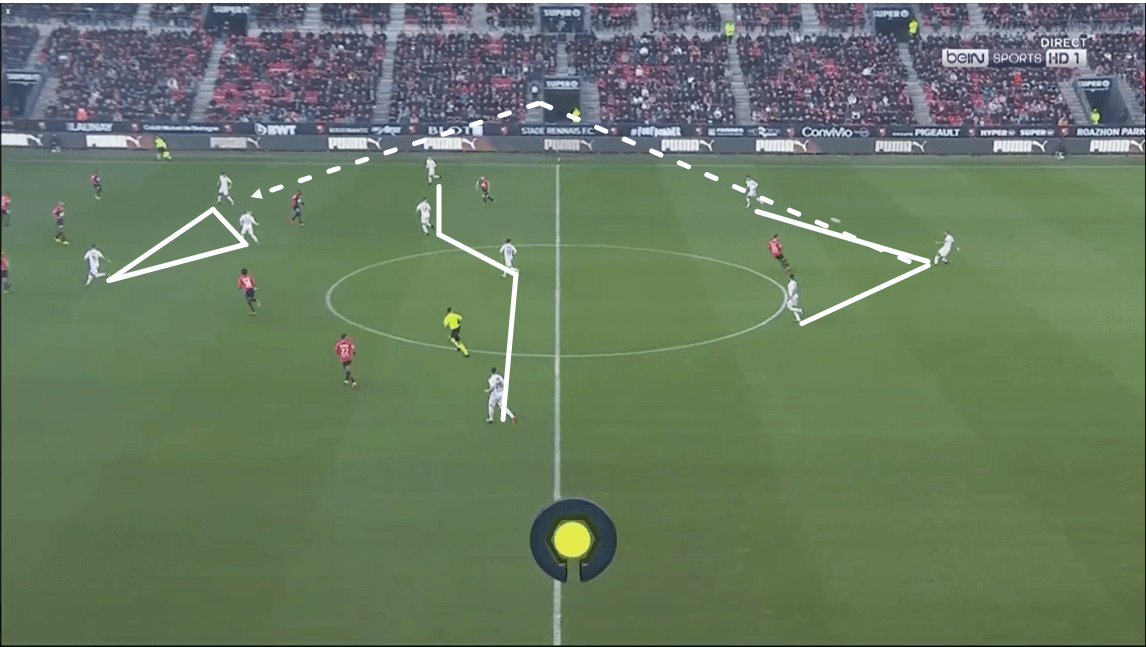
This image above shows us an example of Montpellier’s 3-4-1-2 shape from Sunday’s game. This image was taken from the opening play of this fixture, immediately after kick-off.
Here, we can see how quickly Montpellier’s players assumed their positions within their 4-3-1-2 shape. In addition to that, this image shows us how much space Montpellier allowed to exist between their defensive line and midfield line during the build-up.
As the visiting side’s defence attempt to build out from the back, this image shows us how Montpellier set themselves up to play in a more direct fashion from the outset of this one, aiming to get the ball up to their three attackers as quickly as possible, to then put the Rennes defence under pressure.
In the offensive phase, Montpellier’s shape may have suited them to play more direct. 52 of the visiting side’s 393 attempted passes this past Sunday were long-passes, according to Wyscout, compared to just 35 of Rennes’ 505 pass attempts being long-passes in this game.
In the defensive phase, Montpellier’s preferred 3-4-1-2 shape essentially turned into a 5-2-1-2 shape, with both of their two wing-backs dropping deeper, into the defensive line. Rennes enjoyed some success during the early stages of this game due to their ability to exploit their opponents’ defensive shape.
Montpellier’s defensive 5-2-1-2 shape offered Sunday’s visitors little coverage in the wide areas. Their two central midfielders were left with a lot of ground to cover as Rennes moved the ball around the pitch from one wing to the other in order to create openings in Montpellier’s defence.
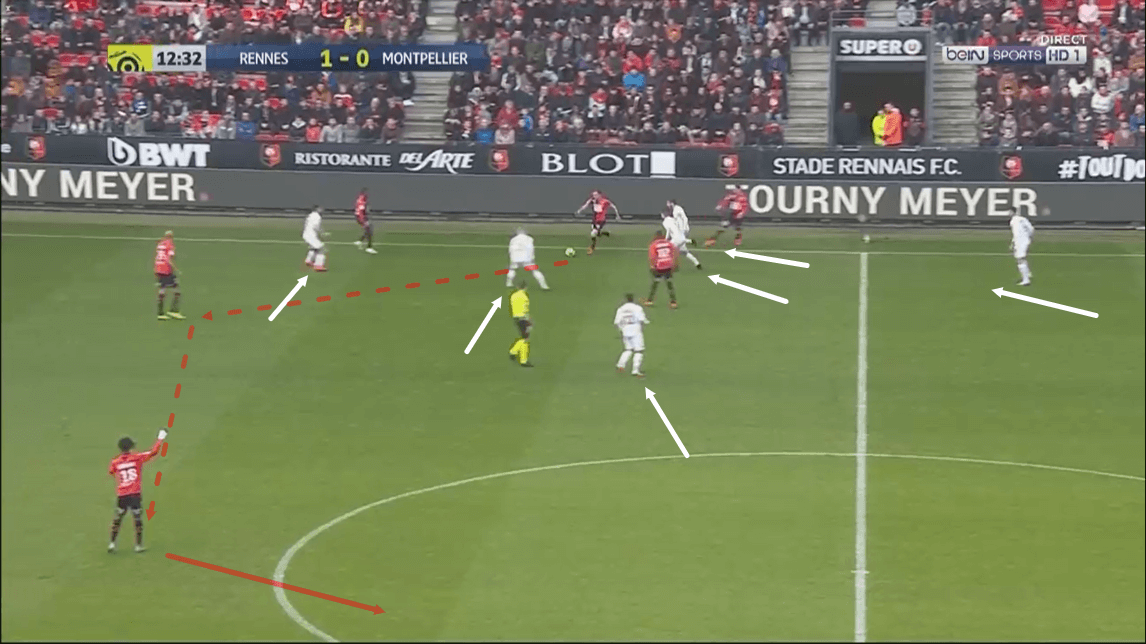
This image above shows us an example of one way in which the home side managed to exploit Montpellier’s defensive shape during the early stages of this game. Montpellier didn’t press Rennes particularly aggressively in this game. The away side’s PPDA (passes per defensive action) stat stood at 28.5, on average, at the end of this game. This indicates that Montpellier’s pressing wasn’t particularly aggressive.
However, Montpellier did have a noticeable pressing trigger, which occurred when Rennes played the ball out to the wide areas of the pitch. As we can see in the image above, plenty of Rennes and Montpellier shirts can be seen on the far-side wing here.
This image shows six Montpellier players surrounding the Rennes player in possession of the ball on the wing at this time, however, this image also shows Camavinga calling for the ball, enjoying plenty of space in the middle of the pitch. As this passage of play moves on, Rennes manage to find their holding midfielder N’Zonzi with a vital pass that breaks the Montpellier press. N’Zonzi subsequently plays the ball forward to Camavinga who can enjoy plenty of space on the opposite side of the pitch due to the number of Montpellier men who participated in the press on their right-wing.
In addition to their aggressive pressing, Montpellier’s defensive width was exploited by the home side who quickly switched play to the opposite wing on multiple occasions during the early stages of this game, forcing the away side’s midfielders to cover a considerable amount of ground in order to try and close down the Rennes attackers.
Rennes’ exploitation of the width, in addition to their impressive ability on the ball, helped them immensely to get the upper hand on Montpellier in the early stages of this game, taking a 2-0 lead by the 28th minute.
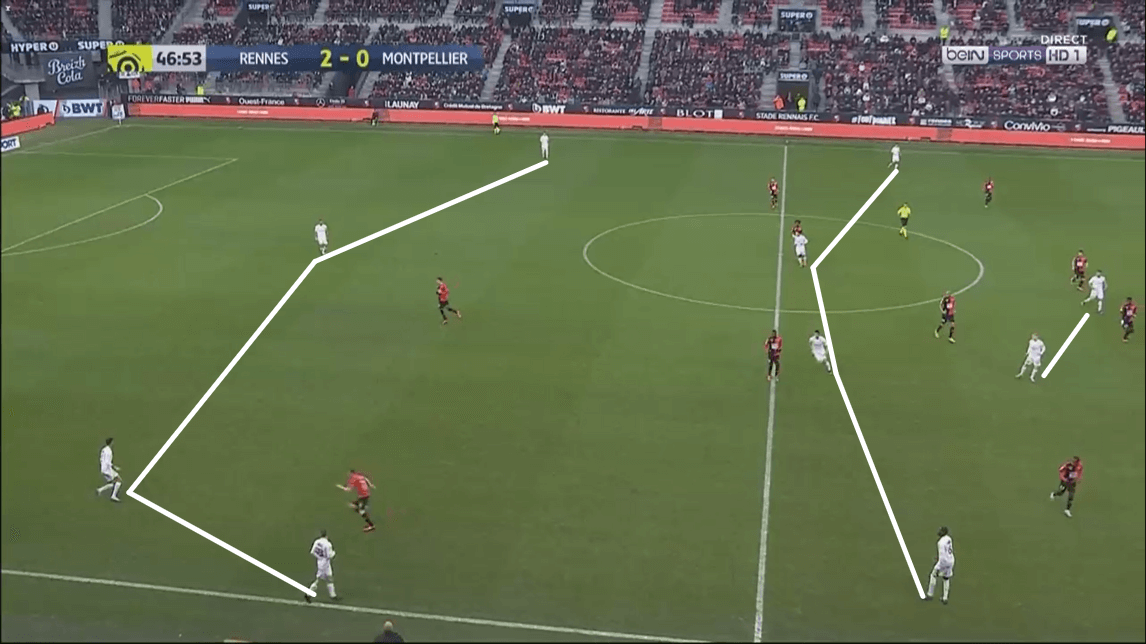
In order to combat Rennes’ intelligent exploitation of their width, Montpellier switched to a 4-4-1-1 shape just after the midway point in the first half. This change in system allowed the away side to defend with more coverage in the wide areas.
Montpellier’s change in system was effective at nullifying the threat that had been previously posed to them by Rennes, via the wings. However, this change in system was also not without its flaws and Rennes still managed to break Montpellier down with their impressive play to score three more goals in the second half.
N’Zonzi’s important role in the build-up
Rennes’ holding midfielder N’Zonzi played an important role for his side during the build-up phase in Sunday’s game. Rather than sitting in front of the defensive line, the 31-year-old midfielder generally sat in between Rennes’ two centre-backs during the build-up in this fixture.
In doing so, N’zonzi helped his side to build out of the back and play through Montpellier in the process with an increased amount of ease. In addition to that, N’Zonzi’s positioning allowed some of his teammates to explore more advanced areas of the pitch, exercising an increased amount of influence in the final third.
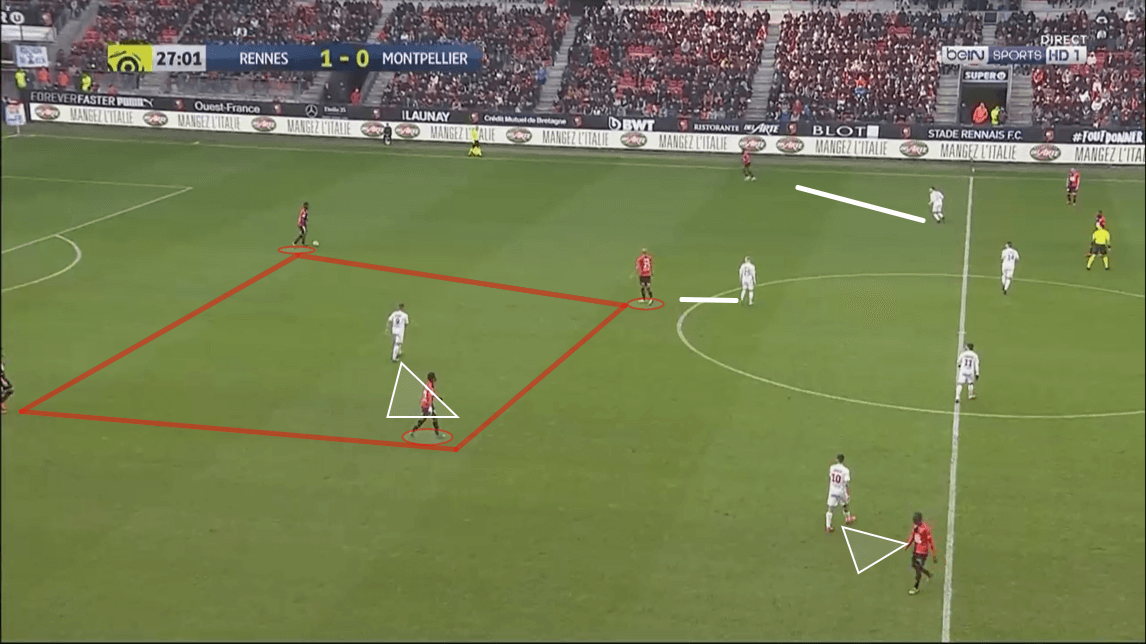
This image above shows us an example of an occasion in which N’Zonzi is not sitting in between the two centre-backs in Sunday’s fixture. Here, we can see the 31-year-old sitting in the midfield line ahead of his two centre-backs, essentially creating a double-pivot alongside Camavinga at the base of Rennes’ midfield.
This image shows us how Montpellier were effectively set-up to defend against a Rennes midfield in which N’Zonzi was positioned in-line with Camavinga in a two-man midfield system. Had the home side played with a two-man midfield and two centre-backs throughout this game, they may have struggled to build from the back to a far greater extent than they ultimately did.
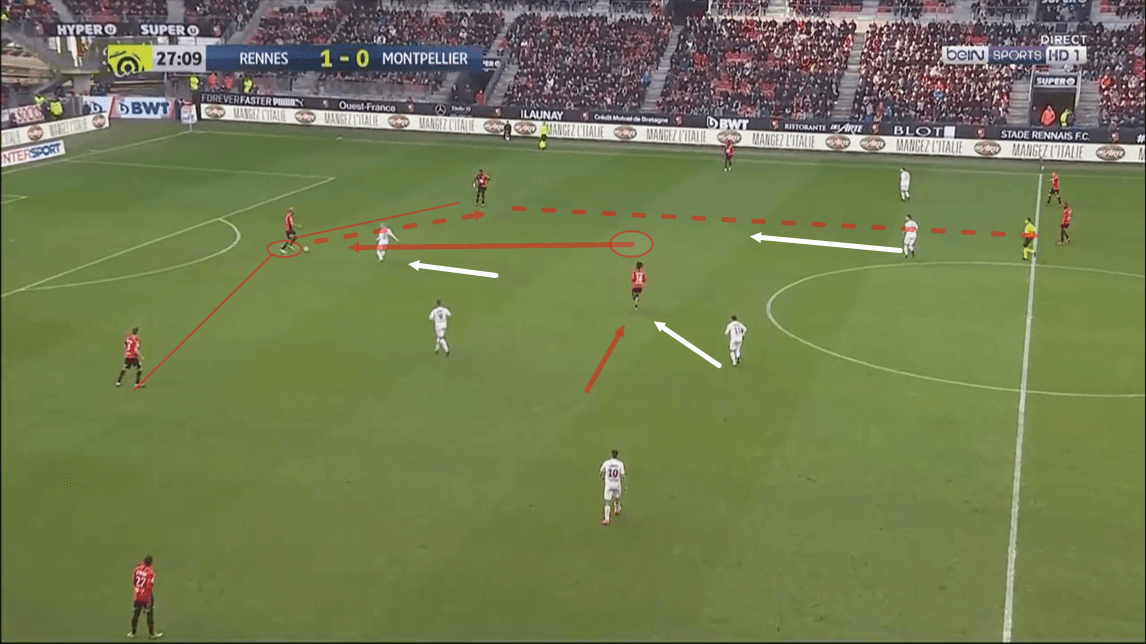
This next image shows us how N’Zonzi’s positioning swiftly changed as this passage of play continued to unfold. Here, we can see N’Zonzi, just eight seconds later, positioned as a part of a three-man backline, in the middle of Damien Da Silva and Joris Gnagnon.
As N’Zonzi dropped into the defensive line, he successfully created an overload in favour of Rennes at the back versus the two Montpellier attackers on this occasion, one of whom we can see pressing the midfielder as he receives possession deep in the Rennes backline.
As N’Zonzi is pressed, he can comfortably pass the ball to left centre-back Gnagnon, who can now go and help his team beat the opposition press by carrying the ball past Montpellier’s first line of pressure and subsequently playing a line-splitting through pass to Léa Siliki, who we can see occupying the left central attacking midfield position in this image.
This passage of play shows us how vital of a role N’Zonzi played for Rennes during the build-up phase of Sunday’s fixture. Before the midfielder dropped into a three-man backline, Rennes were visibly struggling to build out from the back, however, once N’Zonzi dropped into the defensive line, it didn’t take long for Les Rennais to beat Montpellier’s press and begin an attack. This particular attack went on to see Rennes score their second goal of the game.
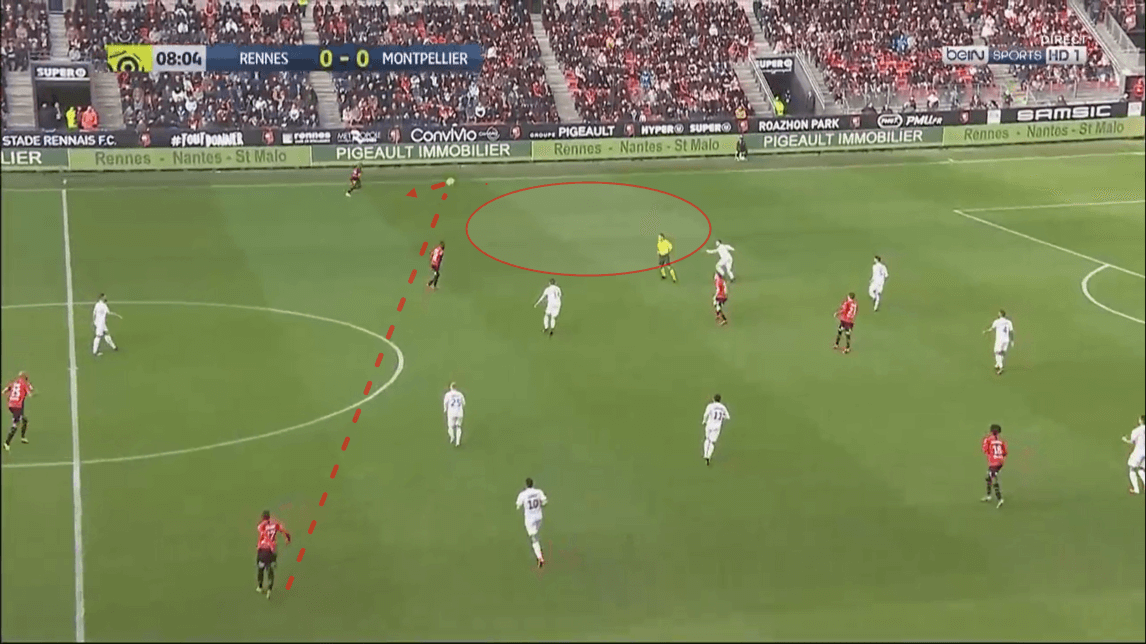
Another important result of N’Zonzi’s deeper positioning in the build-up was that it allowed the Rennes wing-backs to push higher up the pitch, exploring more advanced territory as a result of N’Zonzi covering in the backline. This image above shows us one example of how Rennes’ wing-backs managed to exploit space in more advanced areas as a result of N’Zonzi’s deep positioning.
This image shows us an example of the narrow Montpellier 5-2-3 shape that the visitors deployed out-of-possession in this game, to little success. This image provides a clear example of how vulnerable Montpellier’s defensive shape was, to quick switches of play from one wing to another in the early stages of this game.
In this particular image, we can see right wing-back Hamari Traoré having just played a cross-field ball in search of left wing-back Faitout Maouassa. Traoré had attracted a press from Montpellier prior to playing this pass, due to his wide positioning on the right-wing.
However, upon drawing the press of some Montpellier players, Traoré got his head up and spread the ball across field to Maouassa, who now found himself with plenty of space ahead of him on the left-wing, as Montpellier’s narrow defensive shape didn’t allow them to cover the full width of the pitch.
On this particular occasion, Rennes’ exploitation of the width pays off big time as Maouassa carries the ball inside and ultimately goes on to release a strike that sent the ball flying into the top corner of the net, putting Rennes 1-0 up in Sunday’s fixture.
This shows us how important N’Zonzi’s role was for both the first and second goals this past weekend. The 31-year-old midfielder’s deep positioning helped his side considerably during the build-up phase. Furthermore, N’Zonzi’s positioning within the defensive line gave Rennes’ wing-backs freedom to roam forwards, which helped Rennes to open the scoring in Sunday’s game.
The important creative role of Rennes’ two ‘free 8’s’
Rennes’ switch to a 4-3-3 shape for this past Sunday’s Ligue 1 game allowed them to deploy both Camavinga and Léa Siliki in attacking positions alongside one another with the security of the experienced holding midfielder N’Zonzi sitting behind them. Rennes two ‘8’s were subsequently allowed to enjoy a considerable amount of freedom within Rennes’ system this past weekend, which helped the home side in the creativity department.
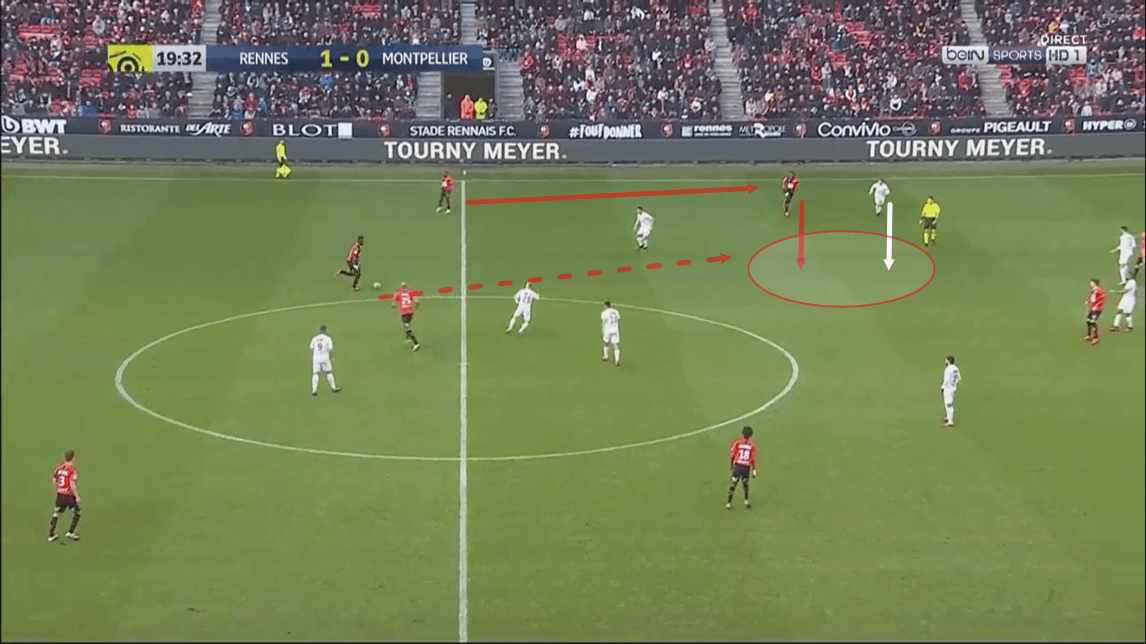
The image above provides us with one example of the large degree of positional freedom that was afforded to Rennes’ ‘8’s in Sunday’s fixture. As we can see here, with N’Zonzi sitting back and Camavinga occupying a more normal right central midfield position, Léa Siliki has shifted out to the left-wing.
Léa Siliki’s positioning here attracts Montpellier’s right wing-back to mark him. Montpellier seemingly deployed a space-oriented man-marking system for large chunks of this game. With Léa Siliki positioned on the left-wing at the beginning of this particular passage of play, the Montpellier right wing-back stuck to the midfielder and subsequently followed him as he drifted back infield to a more regular position where left centre-back Gnagnon found him with a pass.
Léa Siliki’s movement here creates a large amount of space on the left-wing, as a result of the right wing-back man-marking the midfielder as he moves inside. As this passage of play moves on, Léa Siliki carries the ball further infield before laying it off to his midfield partner Camavinga, who subsequently plays the ball back out to the left-wing, finding the run of the overlapping left wing-back who can play an inviting cross into the danger zone.
This attack ultimately fizzles out, however, this passage of play provides us with an excellent example of the important role that was played by Rennes’ ‘8’s in last Sunday’s Ligue 1 fixture. The positional freedom that was granted to Camavinga and Léa Siliki within Rennes’ 4-3-3 allowed them to effectively manipulate the positioning of Montpellier’s defenders, creating space for their teammates to probe into, as Maouassa did on this occasion, in the process.
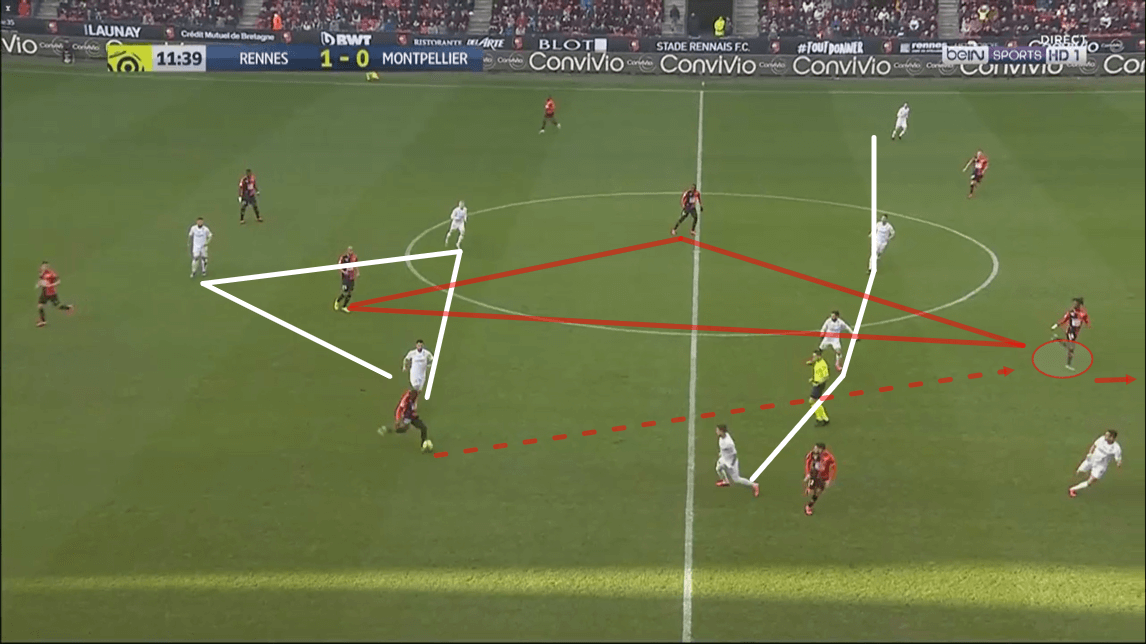
Similarly to Léa Siliki in the previous example, Camavinga also caused plenty of problems for Montpellier’s defenders with his positioning in Sunday’s game. The image above provides us with a clear example of how Camavinga effectively positioned himself between Montpellier’s defensive lines to make himself a dangerous passing option, in addition to putting himself in the optimal position to receive the ball and quickly create chances for his side’s attackers.
As we can see here, similarly to the previous image, the positioning of Rennes’ two ‘8’s is staggered in this image above. On this occasion, Léa Siliki is the player who is occupying a more natural central midfield position, while Camavinga can be seen occupying a more advanced position, behind Montpellier’s midfield line, where he goes on to receive the ball in a dangerous area of the pitch.
Rennes’ staggering of their two ‘8’s made it increasingly difficult for Montpellier’s midfielders to mark them. Montpellier’s midfield was much flatter with regard to shape, compared to Rennes’ midfield. The away side’s central midfield pairing of two may have struggled to cope with Rennes’ two free ‘8’s when they probed behind the midfield line, without a holding midfielder positioned there to stop them, in the vein of the role being performed in this game by Rennes’ own N’Zonzi.
The positional freedom that was enjoyed by Rennes’ two ‘8’s in this game gave the home side a big creative boost. Montpellier struggled to cope with Rennes’ midfield in this game.
Conclusion
To conclude this tactical analysis piece, it’s clear that Rennes’ 4-3-3 shape and their effective midfield trio may have been the key element that gave them a big advantage in this game. N’Zonzi performed intelligently and effectively as a holding midfielder, assisting his side significantly in the build-up phase by positioning himself in between his team’s centre-backs.
In addition to that, Camavinga and Léa Siliki performed effectively in the role of the two ‘free 8’s’ enjoying the increased positional freedom that had been allowed to them due to the security blanket of N’Zonzi operating between the lines behind them.
Rennes did a good job of exploiting weaknesses in Montpellier’s system throughout this game. Initially, the home side effectively exploited the visitors’ struggles in the wide areas when defending, however, as the game wore on, Rennes began to exploit the central areas more and more, which was helped by their in-form midfield trio.





Comments